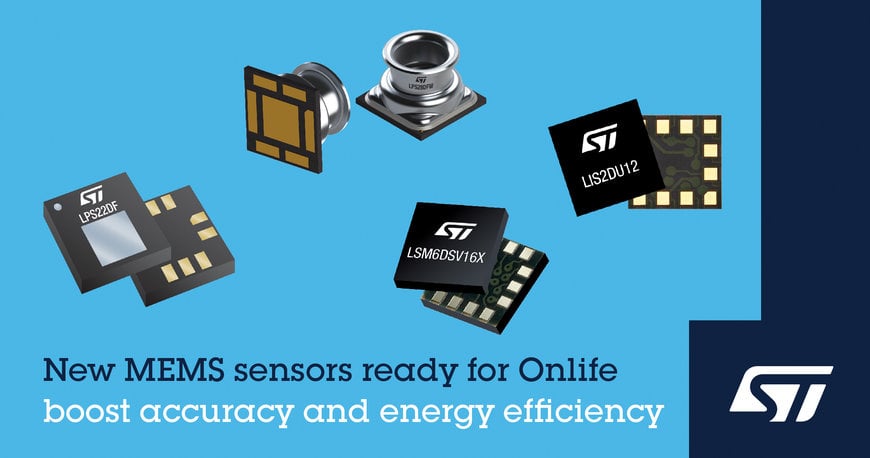Advanced MEMS sensors from STMicroelectronics power-up the Onlife era
STMicroelectronics, a global semiconductor leader serving customers across the spectrum of electronics applications and a top manufacturer of micro-electro-mechanical systems (MEMS), is introducing its third generation of MEMS sensors.

- Third-generation technology increases accuracy and energy efficiency
- Extra features add machine learning in the edge and electrostatic sensing
The new sensors enable the next leap in performance and features for consumer mobiles and smart industries, healthcare, and retail.
MEMS technology is the cornerstone of the robust and chip-sized motion and environmental sensors that drive the intuitive context-aware features of today’s smartphones and wearables. ST’s latest generation MEMS sensors now take performance to a new level, going beyond established technical limitations on output accuracy and power consumption. The new sensors can deliver the highest accuracy for product features such as activity detection, indoor navigation, and precision industrial sensing. At the same time, they keep battery demand low for longer runtimes.
Extra features, to be included in selected variants, include ST’s machine-learning core (MLC) and electrostatic sensing. The MLC brings adaptive, machine-learning capabilities to edge applications that operate at extremely low power. The charge-variation (QVAR) sensing channel monitors changes in electrostatic charge, either through contact with the body in a smartwatch or fitness band or by non-contact sensing (radar). ST MEMS sensors with QVAR can enhance user-interface controls, to ensure seamless interactions, or to simplify detection of moisture and condensation. Radar-mode applications include human-presence detection, activity monitoring, and people counting.
“This groundbreaking new generation builds on ST’s extensive historical investment in MEMS expertise and process technology,” said Simone Ferri, MEMS marketing director, STMicroelectronics. “In addition to revolutionizing the sensors’ performance, we are extending their capabilities with optional electrostatic sensing and machine learning. The result is a new generation of sensors ready for Onlife: life transparently and seamlessly enhanced through technology that is always present, always on, and always connected.”
The new generation launches with the LPS22DF and waterproof LPS28DFW barometric pressure sensors, which operate from 1.7µA and have absolute pressure accuracy of 0.5hPa. The LPS28DFW has dual full-scale capability, enabling accurate vertical position both underwater and out of water. The full-scale range is selectable up to 1260 hPa or 4060 hPa, equivalent to water pressure at a depth of about 98 feet (30 meters). The sensors enhance altimeter and barometer performance in portable devices and wearables including sport watches. Typical industrial applications include equipment for weather monitoring and accurate water-depth sensing.
Also joining the lineup, the LIS2DU12 3-axis accelerometer has been designed expressly to build an outstanding ultralow-power architecture with active antialiasing. The antialiasing filter operates with a current consumption among the lowest in the market. The LIS2DU12 consumes only 3.5µA at 100Hz output data rate (ODR) and is also the first accelerometer off the shelves with I3C interface. All these features are packed in one of the smallest footprints (2.0 x 2.0 x 0.74mm). This accelerometer is ideal for wearable devices, hearing aids, true wireless stereo (TWS), wireless sensor nodes, and any application where system optimization is a must-have.
The LSM6DSV16X 6-axis iNEMO inertial module contains QVAR electrostatic sensing as well as the MLC and a finite state machine (FSM) that enhance response and save power. The operating current can be as little as 12µA. The new FSM enables adaptive self configuration (ASC). With ASC, the device understands the context and reconfigures itself without waking up the system, gaining a significant extra power saving. Soon to enter production, the module has already been demonstrated in an electrostatic radar application for early user detection to accelerate waking-up a laptop PC.
The LPS22DF pressure sensor in 2.0mm x 2.0mm x 0.73mm 10-lead LGA package (available on eStore), and the LPS28DFW in 2.8mm x 2.8mm x 1.95mm 7-lead LGA (with free samples available on eStore) are in production now. They are available at distributors, priced from $1.90. The LIS2DU12 and LSM6DSV16X are scheduled for later in 2022.
www.st.com

